FIND THE TURNING POINT OF A POLYNOMIAL FUNCTION
The graph of every polynomial function of degree n has at most n - 1 turning point.
If a polynomial function of degree n has n distinct real zeros then its graph has exactly (n - 1) turning points.
Graph each function. Identify the x-intercepts and the points where the local maximums and local minimums occur. Determine the intervals for which each function is increasing or decreasing.
Problem 1 :
f(x) = x3 − 3x2 + 6
Solution :
Using graphing calculator
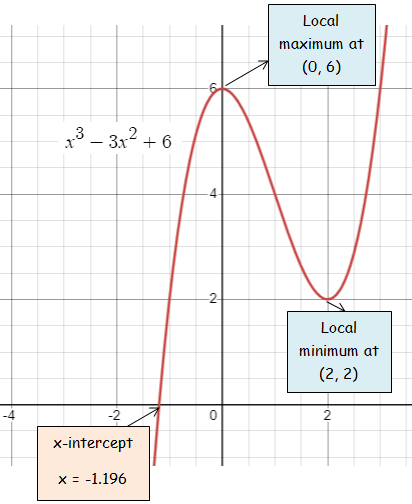
x - intercepts :
x-intercept at x = -1.196
Local minimum and maximum :
Local maximum at (0, 6) and local minimum at (2, 2).
Increasing and decreasing interval :
- When x < 0, f(x) is increasing.
- When x > 0 and x < 2, f(x) is decreasing.
- When x > 2, f(x) is increasing.
Increasing interval is (-∞, 0) and (2, ∞)
Decreasing interval is (0, 2).
Problem 2 :
g(x) = x4 − 6x3+ 3x2 + 10x − 3
Solution :
Using graphing calculator
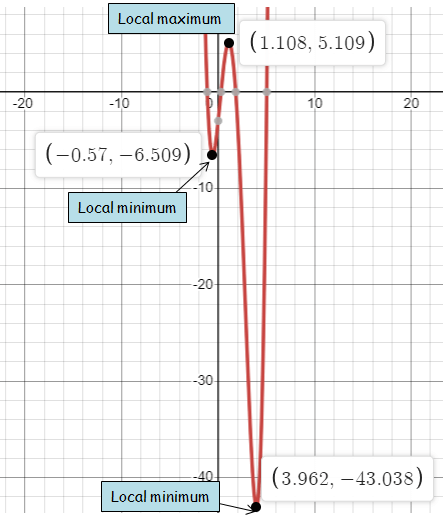
x-intercepts :
The function g(X) has four x-intercepts. x-intercept at
x = -1.137, 0.289, 1.186 and 5.033
Local minimum and maximum :
Local minimum is (-0.57, -6.509) and (-3.962, -43.038)
Local maximum is (1.108, 5.109)
Increasing and decreasing interval :
- g(x) is decreasing when x < -0.57 and 1.108< x < 3.962.
- g(x) is increasing when -0.57 < x < 1.108 and x > 3.962
Problem 3 :
Sketch a graph of a polynomial function f having the given characteristics.
• The graph of f has x-intercepts at x = −4, x = 0, and x = 2.
• f has a local maximum value when x= 1.
• f has a local minimum value when x=−2
Solution :
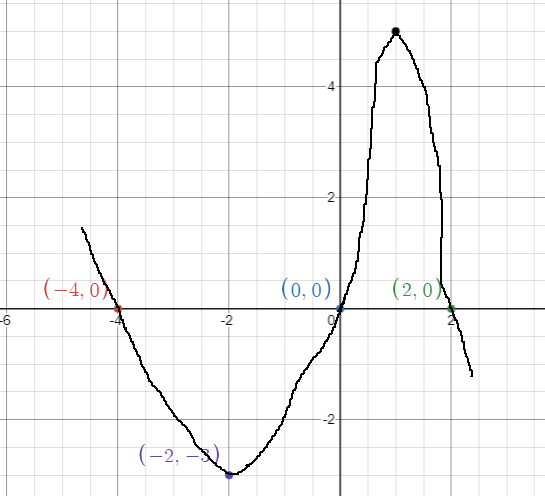
Problem 4 :
When a swimmer does the breaststroke, the function
S = −241t7+ 1060t6 − 1870t5+ 1650t4 − 737t3 + 144t2− 2.43t
models the speed S (in meters per second) of the swimmer during one complete stroke, where t is the number of seconds since the start of the stroke and 0 ≤ t ≤ 1.22. Use a graphing calculator to graph the function. At what time during the stroke is the swimmer traveling the fastest?
Solution :
Using the graphing calculator, by drawing the graph
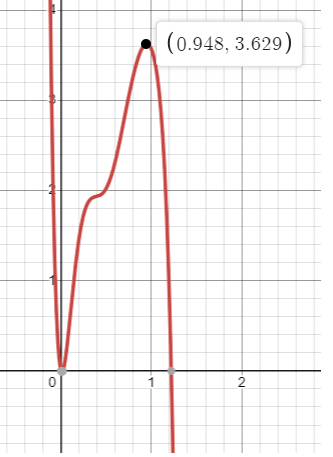
Local maximum appears at (0.948, 3.629). So, the swimmer is going fastest at 0.948 seconds and speed is 3.629 meter/second
Problem 5 :
A polynomial function of degree four is graphed as shown
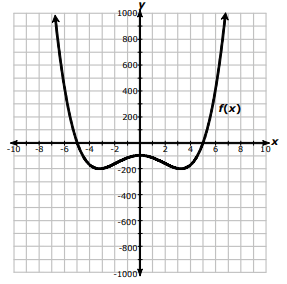
Based on this graph, which statement is true?
a) f(x) has a total of four roots and three local extrema.
b) f(x) has a total of two roots and three local extrema.
c) f(x) has a total of two roots and five extrema.
d) f(x) has a total of four roots and five extrema.
Solution :
From the given information, it is clear the graph has four roots. By analyzing key features, the polynomial function which has n roots, it will have (n -1) turning points.
Problem 6 :
Assuming that each is a comprehensive graph, answer each question
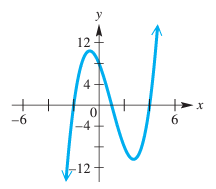
One of the following is an approximation for the local maximum point of the graph in A. Which one is it?
a) (0.73, 10.39) b) (-0.73, 10.39)
c) (-0.73, -10.39) d) (0.73, -10.39)
Solution :
By observing the graph, to the left of y-axis, there is local maximum.
To the left of origin, x-values are negative and maximum appears above the x-axis. So, option b is correct.
Recent Articles
-
Finding Range of Values Inequality Problems
May 21, 24 08:51 PM
Finding Range of Values Inequality Problems -
Solving Two Step Inequality Word Problems
May 21, 24 08:51 AM
Solving Two Step Inequality Word Problems -
Exponential Function Context and Data Modeling
May 20, 24 10:45 PM
Exponential Function Context and Data Modeling